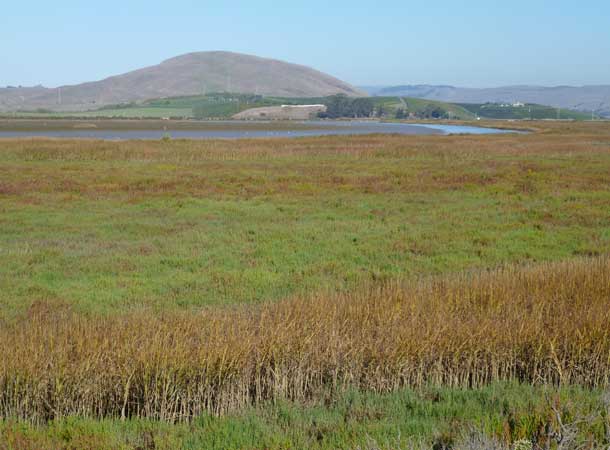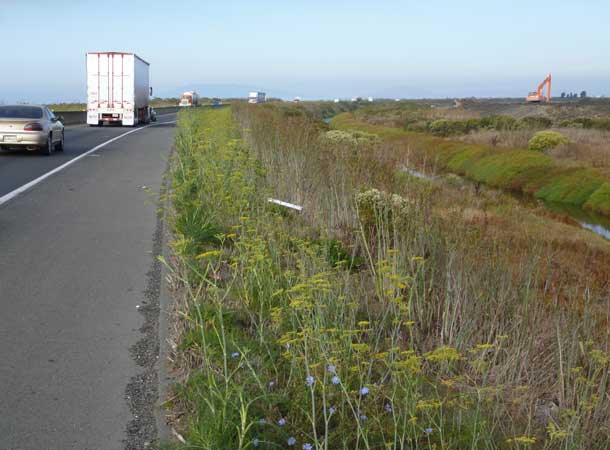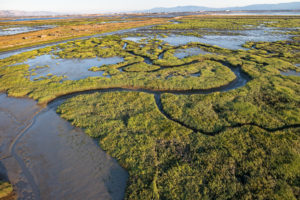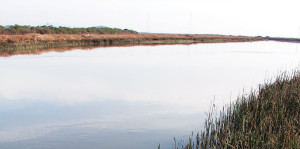At first glance, Cullinan Ranch isn’t much to look at.
Bound by Dutchman Slough to the north and Highway 37 to the south, the Solano County property consists of 1,500 acres of low-lying fields, dotted with clumps of cattails and coyote brush. Only some earthmoving equipment parked on the site hints that this former farmland is about to become the largest restored marsh in the San Pablo Bay National Wildlife Refuge.
“The Cullinan Ranch project is the greatest effort for the refuge so far,” says Don Brubaker, refuge manager. Even more significant, this project is adjacent to the North Bay Salt Pond Complex, a series of evaporation ponds formerly owned by Cargill Salt Company that have already been restored.
“The largest restoration in the San Francisco Estuary to date has taken place in the North Bay, but it’s been done without the pomp and circumstance of the South Bay projects,” says Marc Holmes of the Bay Institute.
So far, nearly 5,000 acres in the Napa River estuary have been converted back to marsh. (Bay Nature detailed the big vision in a 2007 special section, Highway to the Flyway.)
Each new chunk helps turn back the clock.
The San Francisco Estuary once supported 200,000 acres of tidal marsh, not including the Delta. “It’s hard to conceive of the vastness of the marshes, to imagine what the Spanish sailor standing in the crow’s nest saw,” says Brubaker.
Ninety-two percent of these marshes were drained and destroyed, mostly between 1850 and 1930. But the majority of these 180,000 acres lost were not actually filled; instead, earthen dikes cut off tidal flow, and water was pumped out to “reclaim” the land for farmland and pasture.

- Cougar Mountain looms over the wetlands and farm fields along Highway 37 between Napa and Solano counties. Photo by Juliet Grable.
“It wrought havoc with the ecology,” says Homes. “Species that lived only in the San Francisco Estuary were driven to extinction or to the brink.”
After World War II, a growing awareness of the value of marshes checked large-scale fill projects, expressed most clearly in the movement that led to the founding of Save the Bay, which is celebrating its 50th anniversary this fall.
“Organizations began suing to stop development,” says Holmes. “Many cases went all the way to the Supreme Court, and it became very expensive for developers to get their projects approved.” Next came the push to acquire wetlands with public funds.
The history of Cullinan Ranch typifies the shifting attitudes toward land use and wetlands over the last 150 years. Some of its marshes were diked and drained at the turn of the 20th century, others in the 1940s. For decades farmers grew hay and oats here, but in the 1980s the ranch almost became “Egret Bay,” a housing development in the same vein as Bel Marin Keys in Novato. After that project was denied, the US Fish and Wildlife Service purchased the property.
The pace of change here is also typical. Though the land was acquired more than 20 years ago, funding for restoration lagged behind. Construction finally began in October 2011. Westbound commuters stuck in traffic may have already taken note of the growing berm alongside Highway 37.
“The most expensive aspect of the project is to protect the highway from flooding once tidal flow is restored,” says Brubaker.
That won’t happen right away. Work on the protection levee will continue into next year, when construction of acceleration and deceleration lanes will also begin.
Then there’s the issue of land subsidence. “A marsh is like a sponge,” says Brubaker. “Take away the water and the land contracts.” After decades of exposure, parts of Cullinan Ranch are six to eight feet below sea level.
As a result, it has functioned as a seasonal wetland for years. “It has wildlife value right now,” says Brubaker. The ranch attracts dabbling ducks like gadwall, pintail and mallards, along with assorted shorebirds–avocets, black-necked stilts and greater yellowlegs–in winter. A “host of raptors”–including red-tailed hawks, harriers and white-tailed kites– use the area year-round.
At its simplest, marsh restoration involves punching holes in a dike and letting the tides do the work. In many cases, marsh vegetation returns on its own. But sites with subsidence, like Cullinan Ranch, require a more hands-on approach.
“In time, sediment will naturally fill in a little bit,” says Brubaker. “But we’ll still need to bring in several hundred thousand cubic yards of material.” Otherwise, the area would likely become shallow, open water, too deep for marsh vegetation to get established.
Dredged mud from the nearby Napa River will most likely serve as the source of the fill. “But you can’t just dump the material on the site,” says Brubaker. “You have to account for sedimentation rates and other factors.”
That’s where the engineers come in. Engineers from Ducks Unlimited will guide the tides by recreating original channels, which are still evident even after years of farming. Once the prep work is completed, the most dramatic part of the restoration will happen: letting in the water.
“If you ever get to watch a breach, do it!” Holmes says. “The birds are immediately there, and they just go crazy.” The birds are attracted to a bonanza of invertebrates, some of which are already present in the mud before the breach occurs. “As soon as you reconnect the land with the tides, that just explodes.”
The vegetation will come later. The restoration team hopes that cordgrass and pickleweed will colonize naturally, providing habitat for two endangered species: the California clapper rail and the salt marsh harvest mouse.
The restored marsh will serve as a buffet for migratory birds making a pit stop along the Pacific Flyway, and a nursery for resident and migratory fish.
But marshes provide more than ecological benefits; they also improve water quality by filtering sediment and pollutants and helping control flooding.
The benefits far outweigh the cost of restoration projects, says Holmes, but lack of funding is often the only thing standing in the way of actually doing them. “There’s been an absurd failure of government to do something of very significant benefit,” he adds.
“The funding for Cullinan Ranch has been cobbled together,” says Brubaker. Sources include National Oceanic and Atmospheric Administration (NOAA) and $6 million from the California Wildlife Conservation Fund. The total cost of the project will be $16 million.
Other restoration projects are on hold, waiting for the money to come in. One potential solution to the budget shortfall may lie in a piece of federal legislation called The San Francisco Bay Restoration Act. San Francisco Bay is currently part of the National Estuary Program (NEP), the objective of which is to protect and restore “estuaries of national significance,” as designated by the Environmental Protection Agency. Money for restoration projects for these estuaries comes from a common funding pool. Under the new legislation, San Francisco Bay would be authorized as a separate project and qualify for $20 million over five years. The bill has been introduced in both the House and the Senate (follow its progress).
“We get up every day and try to find money,” says Holmes, who also worked with the original team on the Cullinan Ranch acquisition two decades ago. “Right now, the Bay Institute is focused on getting this federal legislation passed.”
Meanwhile, back at Cullinan Ranch, the earthmovers will continue piling up material, each dumpload taking the land one step closer to its pre-Gold Rush abundance.
Brubaker hopes the restored marshes will attract both avian and human visitors. Though they may be a few years away, new facilities will include parking, trails, fishing piers, and even a boat ramp for kayaks.
“We’re putting several million dollars into this project; we want people to come enjoy it,” says Brubaker.

.jpg)





